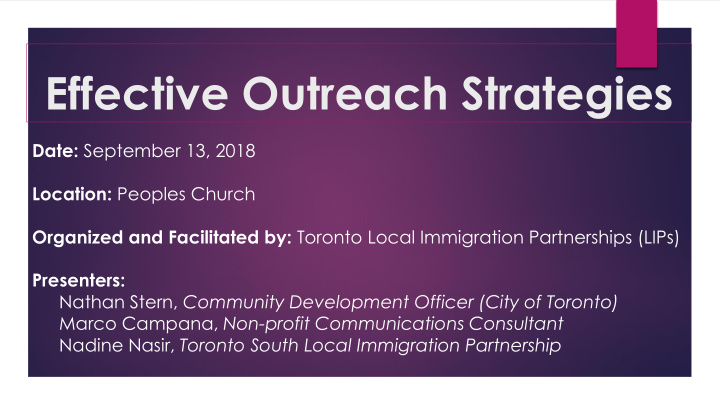



Effective Outreach Strategies Date: September 13, 2018 Location: Peoples Church Organized and Facilitated by: Toronto Local Immigration Partnerships (LIPs) Presenters: Nathan Stern, Community Development Officer (City of Toronto) Marco Campana, Non-profit Communications Consultant Nadine Nasir, Toronto South Local Immigration Partnership
Agenda Agenda 1. Peer knowledge sharing 2. Community engagement 3. Inclusive outreach 4. The use of technology in outreach 5. Creating an outreach plan 6. Train-the-trainer demonstration
Resources To be Shared Electronically: Workshop PowerPoint presentations “Train -the- Trainer” PowerPoint presentation Outreach Tips and Reminders Outreach Ideas Outreach Plan
Peer Knowledge Sharing Agenda
Community Engagement Nathan Stern Community Development Officer City of Toronto
Inclusive Outreach Remember to involve traditionally “marginalized” groups in society in your outreach. Accessibility is key to participation. Consider: providing language interpretation providing child care organizing outreach/events at times that people are most likely reimbursing transportation fees able to attend ensuring buildings are accessible to people with disabilities ensuring that events are no cost (or low cost if necessary) Remember the power imbalances that exist. Ask yourself questions about power, such as: • Is it possible that I will be seen as an “authority figure”? Will people be comfortable speaking to me? What can I do to minimize the power imbalance? • Will people assume that they have to participate because I have asked them to? Do they think that they should participate in order to access a service? Are they just participating because they don’t want to upset me? • Am I gathering people that may have conflict with each other in the same space? Are minority groups or oppressed groups going to be comfortable contributing? Create a safe space . Remember the various levels of oppression and discrimination that people face, and keep this in mind in every single part of outreach, program design and implementation, and service delivery. Consider how gender dynamics may impact your outreach.
The Use of Technology in Outreach Marco Campana Non-profit Communications Consultant
Create an Outreach Plan Work in groups to create an outreach plan. You can either: A) Choose a scenario that someone in the group is currently working on; B) Choose one of the scenarios on the handout entitled “Create an Outreach Plan Exercise”.
Train the Trainer Presentation Effective Outreach Strategies Date: Sept. 13 2018 Location: Peoples Church Organized and Facilitated by: Toronto Local Immigration Partnerships (LIPs) Presenters: Nadine Nasir, Toronto South Local Immigration Partnership Nathan Stern, Community Development Officer (City of Toronto) Marco Campana, Non-profit Communications Consultant
The Use of Technology in Outreach 1 It's not all about technology; listen to your clients & communities Figure out how newcomers access, find & use information and how they use technology in their daily lives Technology is more than social media Be strategic in your technology choices & implementation Privacy, security & confidentiality are part of design, not afterthoughts Just because newcomers are connected doesn't mean they're not vulnerable
Good Practices 2 Create an outreach plan Make community engagement your goal work collaboratively “ with ”, rather than working “ for ” or providing “ to ” • build relationships with the community • Learn as much as possible about the people you want to outreach to Personalize communications Be inclusive . Ask yourself: Is everything accessible? • Are marginalized groups included? • Have I addressed any barriers to participation? • What are the gender considerations and dynamics that I should be aware of? • Is it culturally appropriate? •
Good Practices 3 Reflect on power dynamics: Am I gathering people that may have conflict with each other in the same place? Will minority groups or oppressed groups be comfortable participating? Is it possible that I will be seen as an “authority” figure? Will people be comfortable speaking to me? Will people assume that they “have to” or “should” participate in my program in order to access a service? Do people feel pressured to participate because they don’t want to upset me? What can I do to minimize the power imbalance?
Outreach Tips 4 Address the needs that have been identified by a community Remember your ultimate goal , as it is easy to forget with the pressure of meeting “targets” Be confident! Evaluate each outreach tactic used Did it achieve your goal? How could you improve if you were to do it again? Did anything surprise you? Were there any unanticipated barriers or obstacles?
Partnerships 5 Form partnerships and build relationships with people that can help you outreach, • including community leaders . Always ask yourself: What does the person I am partnering/outreaching with have to profit or lose from this • collaboration? Is this person able to help me outreach to ALL people within this community? • Will they act as “gate - keepers”? Who will NOT be outreached to if I work with this • person? Who will not be comfortable participating if I work with this person? • What are the potential power imbalances that I need to be aware of? For example, • will people feel like they have to participate because their community leader asked them to? Build relationships with the broader community, and remember that reciprocity is • important.
Outreach Ideas 6 Announcements Events Community events BBQ Cultural events Guest speakers Places of worship Poetry slam Meetings Open house Conferences Arts & Crafts WORD OF MOUTH Art Group activities Organize a performance to Zumba capture attention and talk to people. Knitting Book club Skit Potluck Dancers Painting Singers Embroidery Displays Sports
Nadine Nasir Adult Educator Toronto South Local Immigration Partnership St. Stephen’s Community House 647-460-1569 nnadine@sschto.ca
Recommend
More recommend